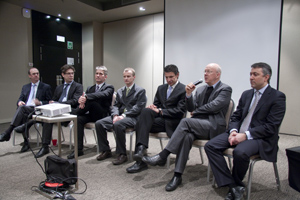|
As smartphone and tablet fever continues to propagate around the world, it was inevitable that it would quickly spread to professional communications. Workforces accustomed in their personal lives to new devices and applications, coupled to ubiquitous broadband wireless connections, now understand how these tools could help them do their jobs more efficiently. And increasingly the customers and the public they serve are coming to expect the same advanced tools to be available for their care and protection. But while fourth-generation mobile services ramp up in the consumer world, professional radio users in activities such as PPDR (public protection and disaster relief) and the public utilities remain more or less frozen in a 2G era of narrowband voice and data. And the gap grows ever wider as consumer technology, propelled by a huge global investment, races away into a broadband wireless future. What, then can be done to meet the future needs of critical communications users? Can TETRA services be coupled in some way to the powerful consumer-grade services, to share the benefits of advanced features and low prices? Do other possibilities exist? At a workshop meeting staged in Barcelona by the TETRA + Critical Communications Association (TCCA), some 85 participants from all parts of the critical communications community met to consider ways forward. Among them were representatives of standards bodies, the radiocommunications industry, network operators and users of mission-critical and business-critical radio systems – in emergency and rescue services, in transport, the public utilities and in industry. A shared problem Over two days of presentations and discussion, it emerged that potential solutions do exist, though they call for much time and effort, and a spirit of co-operation. And it was learned that the TETRA community is not alone in its predicament: users of other digital technologies, including France’s Tetrapol system and the GSM-R standard adopted by many of the world’s railways, likewise require a broadband upgrade path and may be willing to join forces with TETRA to create one. Opening the meeting, Phil Godfrey, chairman of the TCCA, said: “In the TETRA community, we recognized that the demand for higher data rates was increasing and we developed TETRA Enhanced Data Services, TEDS. This offers wideband data up to 500?kbit/s or more. However, a lack of easy availability of spectrum and maybe some similar limitations on the handset capability, have stifled its use, at least so far. “So what is the answer? We are all aware of the fact that 4G networks are coming. In some countries they are being rolled out already. So will these networks satisfy the demand from professional users? Well, in my mind there is no doubt that commercial 4G services will be used in the mission-critical and business-critical arena.” But he cautioned: “We must not get seduced by the superficial benefits of using technologies that were not designed for delivering critical communications.... Let us not be responsible for short-changing those that look after the health and welfare of the citizens of this world.” Some progress, Mr Godfrey said, had already been made. The need for a spectrum allocation for future broadband services has been raised with regulators and is now incorporated into the European Commission’s Radio Spectrum Policy Programme, and a CEPT team is at work to identify suitable frequencies. A working party is formulating user requirements and in ETSI there is a project to review possible solutions for mission-critical communications. And the TCCA has established contact with the Third Generation Partnership Project (3GPP), the worldwide standards-making group responsible for developing 3G and 4G mobile. “In the United States, the public safety community has already made a commitment to create a nationwide broadband network”, Mr Godfrey continued. “Spectrum has been set aside in 700?MHz and the government has set a budget of around $18 billion to fund it. They have also decided that LTE will be the technology that is used. This is some impressive progress and demonstrates how quickly they can move when the political will is there.” But for the rest of the world to catch up, close co-operation between all interested parties would be essential, and here the TCCA was ready to play a co-ordinating role. “It is easy for users to claim that their needs are unique and concentrate only on developing requirements for themselves”, Mr Godfrey said. “But I am quite certain that neither the regulators or the standards makers will respond to separate approaches from public safety, from utilities, from transport and from others. They
|

 At a TCCA event in Barcelona, stakeholders met to chart a common path towards broadband wireless for critical communications users. Richard Lambley was there
At a TCCA event in Barcelona, stakeholders met to chart a common path towards broadband wireless for critical communications users. Richard Lambley was there